
Mink and pig farms might spark a catastrophic bird flu pandemic among humans by evolving a strain capable of efficient mammal-to-mammal transmission. This is an ongoing research project, with updates to this article as I find them.
My main thoughts:
- There's more traction than I thought for combatting mink farming on both the demand and supply side. Fur demand is fading and a lot of farms are operating at a consistent loss. On the other hand, this might be a temporary situation driven by the bullwhip effect rather than by activist pressure and fading demand. Fur overall remains a $40 billion global industry. At about $10,000-$20,000 per mink coat, and with enough mink pelts produced annually to make about a million coats, minks alone appear to account for around 25%-50% of the total global fur industry, possibly more.
- Farms are paranoid, possibly for good reason, that even telemarketers are what they consider terroristic animal rights activists. That makes me pessimistic about adoption of engineered biosafety solutions. However, I think several safety measures are still work exploring.
- Build nets to stop bird:mink contact.
- Shifting from wet to dry food.
- Use barn-only shoes to stop workers from tracking infected bird poop into barns.
- Promote routine respirator and vaccine use among farm workers.
- There's at least one startup, Geneus Biotech in Amsterdam, working on cultured fur, which seems promising, although it may take at least another year to reach consumers.
- It may be best to focus on banning the weak and potentially vanishing fur industry, while installing biosafety improvements at the gargantuan global network of factory farms.
- Neither of these approaches would be easy, but this is a critically important issue and both engineered and regulatory solutions seem at least viable.
A looming bird flu pandemic in humans
We are in the middle of a horrible bird flu pandemic among wild birds and poultry. The H5N1 strain has historically had about a 50% case fatality rate in humans, but it currently does not transmit efficiently between mammals, including humans.
If some strains of bird flu such as H5N1 transmitted efficiently among humans, and stayed just as deadly, it would be a civilization-threatening catastrophe far beyond anything we experienced with COVID-19.
Five months ago,[1] H5N1 not only jumped to minks, but spread efficiently among them. This was on a partially open-air Spanish mink farm, and minks were fed on raw fish and poultry products, among other items. Over 50,000 minks were culled.
Scientists have sounded the alarm that mink farms could generate a bird flu strain capable of causing a human pandemic. Mammal-to-mammal transmission among minks could evolve a virus adapted for efficient transmission in mammalian lungs.
Zeynep Tufekci suggested a number of interventions for preventing or mitigating a bird flu pandemic.
- Shutting down mink farms
- Improving bird flu surveillance networks and expanding them beyond the poultry industry to pig farms
- Expanding testing services and stockpiles of vaccines and antivirals
- Developing new and better vaccines, such as mRNA vaccines or a universal flu vaccine
- Voluntary vaccination of at-risk farmworkers and healthcare workers
- Expanded vaccination of poultry
In this scenario, the most decisive steps for preventing a human pandemic is preventing the mink farms from getting infected, and preventing the disease from jumping to the farm workers.
Shutting down mink farms
Shutting down mink farms may be the most effective option, and could also have animal welfare benefits. I think it's seriously worth pursuing.
This doesn't have to look like a simple ban. It could also be a coordinated buy-out, and there are already efforst in this direction, at least in the USA according to KOIN. The mink industry is becoming less profitable every year because of falling demand.
At the same time, the industry appears to be deeply insular, highly and perhaps rightly suspicious of being surveilled and possibly attacked by animal rights activists. A blueprint for ending the fur industry was published in 2009 called The Blueprint: Complete Guide To Ending The Fur Industry. It's exceptionally well-written and engaging simply from a literary standpoint.
The writers drove around to locate fur farms, then published their addresses, layouts, photographs, and operational status, which at least one fur farmer described as "a terrorist handbook." In response, the Fur Commission stated "The days of finding security by keeping a low profile in a rural location are over." Apparently pelts have recently gone through a period of being sold at a loss for at least 4 consecutive years.
- WARNING: Anyone even looking at this stuff should be aware that the FBI is surveilling Peter Young, the publisher of this document, and I would not be surprised at all if it's easy to end up on their watchlist by associating yourself.
I put Billie Eilish at the top of the post because she convinced Oscar de la Renta to end its profitable business in furs. Celebrity anti-fur activism seems like a key way to kill demand for furs among the people who actually buy them.
According to the Humane Society, "An increasing number of fashion designers and retailers are dropping fur cruelty. In the last few years alone, Moncler, Dolce & Gabbana, Canada Goose, Oscar de la Renta, Valentino, Gucci, Burberry, Versace, Chanel, Prada and other high-profile brands have announced fur-free policies."
According to Glossy (4 days ago), "These bans and culling of millions of minks led Kopenhagan Fur, the world’s largest fur auction house, to announce that it will be closing this year...
Overall, fur is quickly falling out of the fashion zeitgeist. London Fashion Week banned fur at shows in 2018. In 2022, it was joined by Copenhagen Fashion Week, where a recent Margot Tenenbaum-themed runway show by Baum und Pferdgarten featured zero mink coats. Schiaparelli’s recent viral fashion show with Kylie Jenner’s famous lion-head dress was an entirely faux-fur affair.
In global luxury capital France, a 2021 poll by the Institut Français d’Opinion Publique (IFOP) found that 90% of the population is opposed to fur. A 2019 Boston Consulting Group report found that animal welfare was the top sustainability concern among Gen-Z luxury customers, while 64% of Gen-Z and millennial shoppers said sustainability impacts their purchase decisions. But demand for mink fur certainly still exists, especially in other global markets: Luxury consumers in China are still interested in buying fur, for example."
However, there are three main reasons I can see why this approach may prove unsuccessful, at least if we're targing the supply side:
- Despite falling demand, as of December 2022 about 100 million minks are killed for pelts annually, meaning there are about 50 million in pelt farms at any given time. With about 50-60 minks per coat, that's the equivalent of about 1 million new mink fur coats per year. Furthermore, industry turmoil appears to be driven by the bullwhip effect, with high demand in 2013 leading to overproduction and a subsequent downturn in prices. Farms may "pelt out," killing their animals and selling at a loss, then re-emerge when prices shoot up again. Banning farms in one place may just cause the price to shoot up again faster. The more farms are banned, the more valuable it is for remaining farms and their suppliers and buyers to invest in securing their business both from activists and from regulators.
- Industry and consumers might respond to a mink farming ban by expanding factory farming of other sources of fur.
- If responsible countries shut down their mink farms, irresponsible countries might move to satisfy global demand, resulting simply in a shift of mink farming from more responsible countries to less responsible countries.
Netted enclosures for farms
A second intervention might be shifting to enclosed barns. I briefly considered the idea of a hard closed barn, like this:
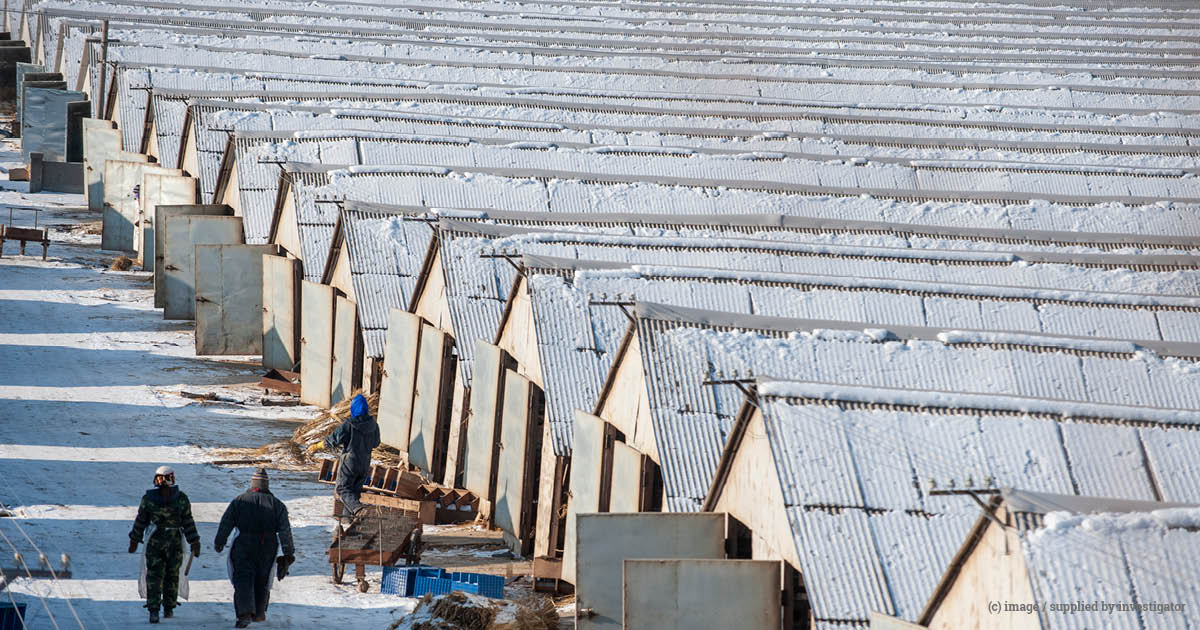
However, building barns like this would be expensive, cause a massive logistical disruption in the farm's operations, and might create an unfavorable tradeoff by decreasing ventilation within the barns. A better solution, I think, would be some sort of netting structure over the barns. It might look like this, but with a barn underneath.
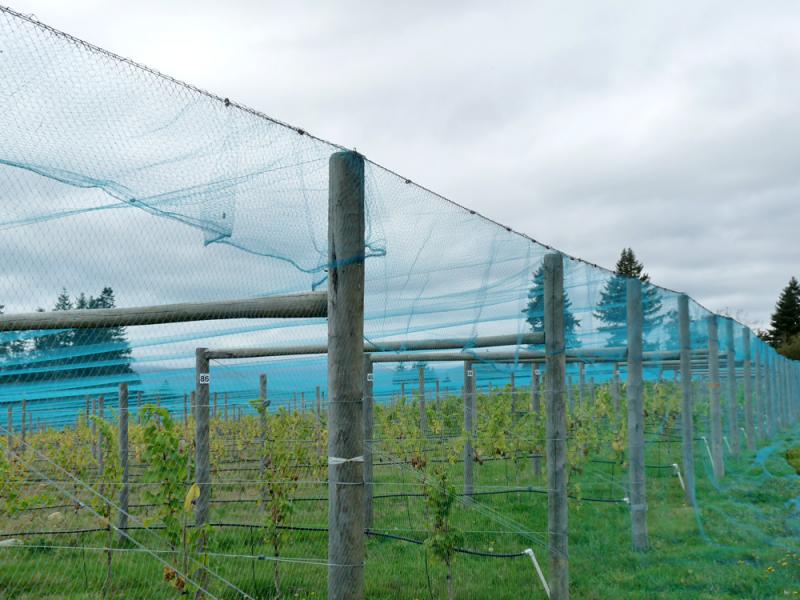
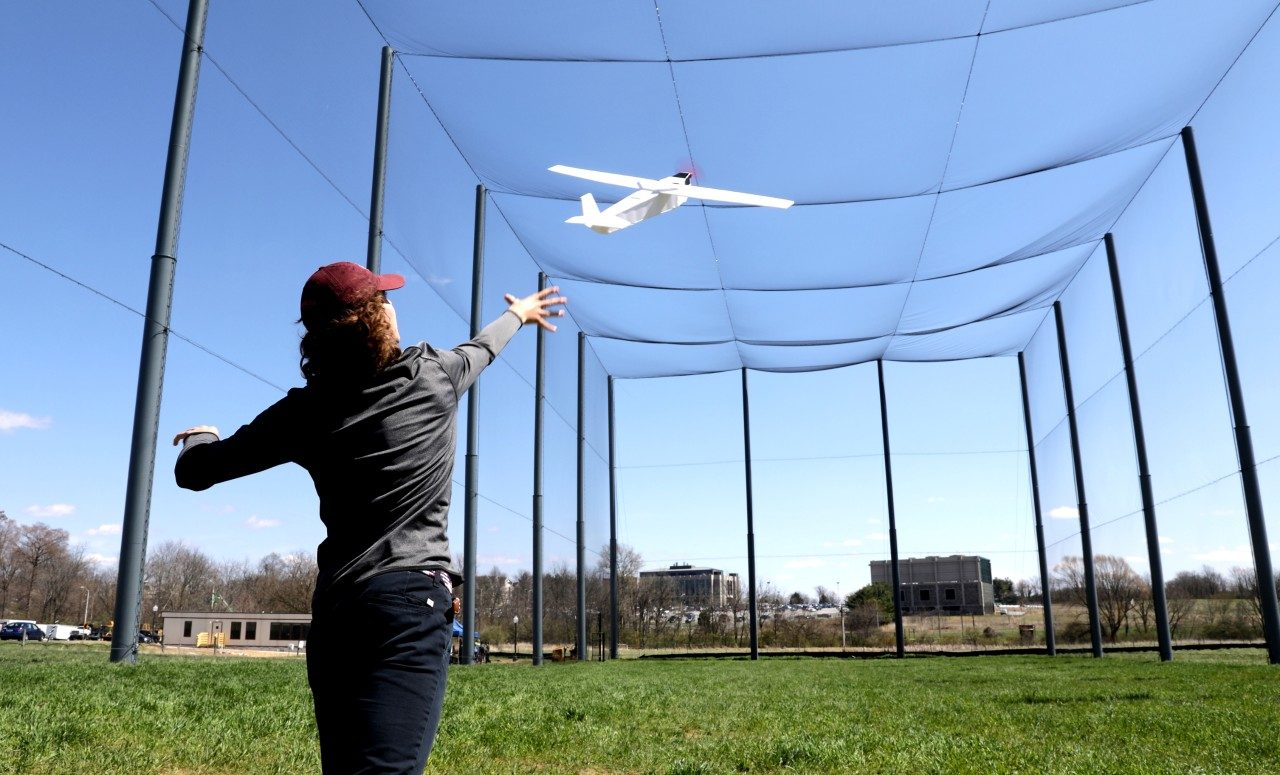
It's possible that mink farms would enthusiastically adopt this technology on their own, to mitigate the risk of having their entire farm culled due to a bird flu outbreak. They might just need the idea and a concrete path to get it installed. It might represent a significant capital investment, and finding solutions to reduce or eliminate that burden might help as well.
One huge advantage of a netting enclosure is that it eliminates the need to enforce a behavioral change on farm workers. Nobody likes wearing a mask on the job, and convincing the entire global industry of mink farm workers to wear masks at all times from now on seems incredibly hard.
One downside is that it's probably much more expensive to build netted enclosures than to buy masks for all the farm workers, and the netting would need to be maintained.
A second limitation is that netting would not block bird poop. However, it seems like many open-air mink enclosures have roofs, and it may be possible to use special footware and decontamination to prevent workers from tracking contaminated bird poop around on the farm.
A third problem is that minks are sometimes fed poultry products which could be an additional vector. Perhaps a combination of addressing contact with birds, bird poop, and contaminated poultry-based feed would be the most effective solution.
Mink Farm Feed
This is a stub section, I'll continue adding to it as I research more. According to SentientMedia.org's article on mink factory farming:
In farms, mink are fed a paste of fish, chicken, cow, pig, and other leftover meats from the animal agriculture industry. It is placed on top of their wire-topped cages daily for them to feed on.
Understanding what kind of quality controls exist for this feed paste to prevent it containing infectious raw poultry meat would be a valuable next step. I would not be surprised if there are epidemiologists looking at the issue, or companies working in the mink farm feed space.
- You can inactivate bird flu in corn-based chicken feed easily, and this gets studied, but it's not relevant to decontaminating bird flu in meat paste fed to minks. [1, 2]
- You can decontaminate turkey meat and eggs with high-energy irradiation [1]. Cooked poultry is not thought to pose a transmission threat [2].
- We've found infected imported meat [1, 2].
- A review of inactivation protocols is here [1].
- Complete heat/pressure-based inactivation of AIV in poultry meat requires heating to 70 C for 5 seconds, or 500 MPa.
- 500 MPa is the level of pressure you'd experience at the bottom of an ocean 30 miles deep.
- 70 C is about the temperature of a mug of hot tea. My guess is that heat-based inactivation is more tractable than pressure-based inactivation.
- Complete heat/pressure-based inactivation of AIV in poultry meat requires heating to 70 C for 5 seconds, or 500 MPa.
So the next question is where mink farms typically get their meat paste, and what sort of decontamination treatment, if any, it normally gets.
An interesting article from Penn State college of ag science
- From 1964-1972, there was an industry-funded research project that found that conventional wet mink food, prepared by grinding up whole animal carcasses right on the mink ranches, could be replaced by dry diets. Dry diets are half the cost and eliminate sanitation problems, but produce pelts that are nearly as large and just as valuable. However, major fur processors had already invested in wet food processing facilities and didn't want a feed alternative that gave an edge to smaller competitors, and that combined with funding loss in the 1972 election killed this project.
- That was 55 years ago, so maybe things have changed since then?
- Unfortunately, the author of this article passed away in 2013. I'll try contacting Jonathan Campbell at Penn State, who's the meat extension specialist and is an expert in processed meats, thermal processing, smoking, and hazard analysis critical control point systems.
Microbiological quality of mink feed raw materials and feed production area (2019)
- "Feed factories supply the mink farms with pumpable wet feed consisting of a mix of animal by-products and slaughter offal (e.g. by-product from the fishing and meat industries) and plant origin (e.g. corn gluten meal, soybean oil and extruded cereals)."
- Lots of previous studies link various disease outbreaks on mink farms to their feed.
- I've emailed the corresponding author to ask about why mink farms continue to be fed wet mink food even now.
Require respirators on mink farms
Requiring mink farm workers to use respirators might be a tractable strategy for preventing mink-to-human transmission. It's good for the farm owners, because it lowers their potential liability and offers a safety-boosting alternative to having the entire global industry shut down. It already has precedent, at least in Spain. It's possible to get a partial implementation by directly appealing to mink farms. They could be incentivized to implement this policy, perhaps by subsidizing their respirators or monitoring and rewarding compliance.
On the Spanish mink farm, they only started testing for a disease outbreak when they noticed that weekly mortality among minks had tripled. That potentially leaves a significant time lag during which farm workers could be exposed to infected minks, without yet noticing that there was something unusual going on. Even if farm workers consistently already use respirators when they're testing for a disease outbreak, I think it's extremely unlikely that respirators are consistently used by mink farm workers around the world during normal times. That may need to change.
Cultured Fur Replacements
The big doubt about cultured meat is whether it'll ever be cheap and realistic enough to compete on taste and price with animal meat. Unlike cultured meat, fur is a luxury product. Furs might even be Veblen goods, with demand increasing with price at least to some extent. We already have faux fur, yet animal fur is still a $40 billion global industry. Potentially, cultured fur could satisfy the appetite for ethical, fashionable fur despite the fact it would undoubtedly be expensive, especially considering the much smaller size of the global fur industry relative to the global meat industry.
Amsterdam-based Geneus Biotech is a startup working on this project, producing Furoid, Wooloid and Hairoid with 3D bioprinting [1, 2]. They're aiming for commercial launch in 2024 and have received a 4 million EUR grant from the EU Commission. I don't yet see images on their website clearly labeled as depicting the fur/wool/hair, only magnified images showing individual hairs embedded in the bioprinted skin-like scaffold. Below are some images their founder, Henri Kunz, sent me from a press release.
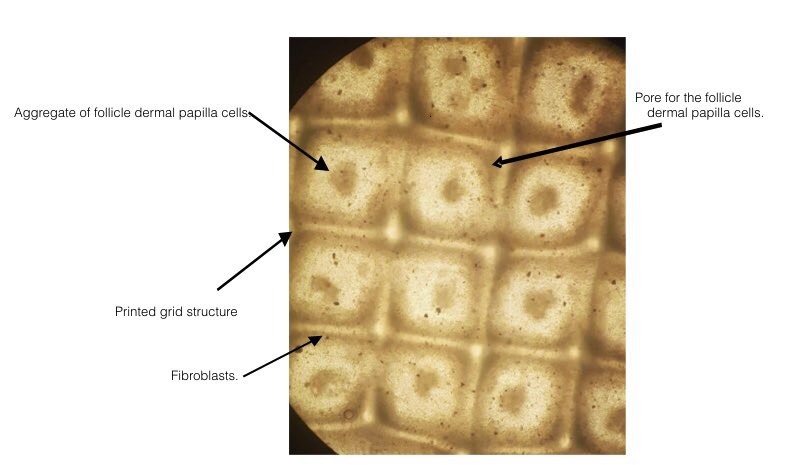
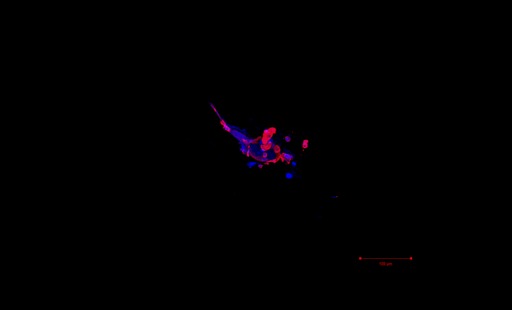
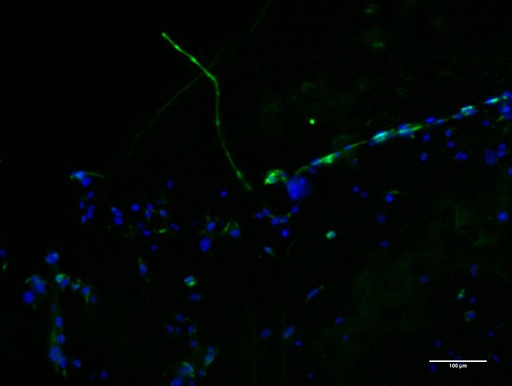
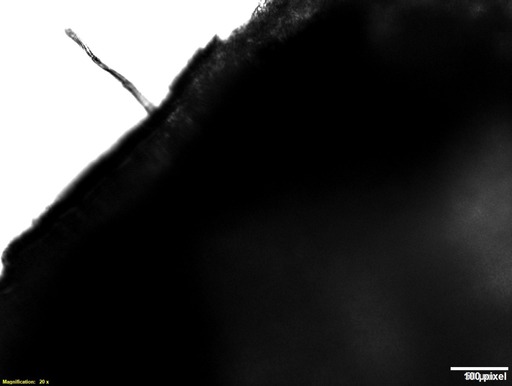
This may be a longer-term effort, since they'll both face competition with the broader fur industry and need to wait at least another year before their commercial launch. It's hard to know what the limits of the technology will be, or to what extent it will substitute for farmed pelts. We might be facing the prospect of a mink-farm-related H5N1 pandemic this year. However, I think their research sounds exciting and support their efforts.
- ^
October 2022

Interesting post!
A very minor comment:
I think fighting mink farms is substantially easier than fighting factory farms given that (1) most people eat meat, but few people wear fur, and fur is a luxury good, (2) people seem to disapprove more of fur farming than meat eating (hence all those "if you're ok eating meat, why not wear fur?" articles, also see here), (3) the fur industry is smaller than the animal food industry, and as a result likely less powerful (global fur revenue is, I reckon, ~2 OOM lower than global meat revenue), and (4) some places (e.g. California) have banned the sale of fur, whereas that'd be nearly unthinkable for factory farms right now.
The amount of places that have banned the fur trade is actually pretty high, so I'm guessing there could continue to be good traction with more resources. Here's a good overview (source):
Keep in mind that most mink farming takes place in Denmark and Poland.
My gut reaction is this is a map of the formerly low hanging fruit, now picked. My understanding is that most fur consumption is in China and Russia. China was willing to take extreme measures to try and suppress COVID, so maybe they’d be willing to shut down their fur trade to prevent an H5N1 pandemic? I feel pessimistic but I’m not sure why.
Putting more pressure on governments to slow down producers in Poland and Denmark could also work.
Yeah, that's where I'd look next. I also linked to a proposed mink farm ban in the USA, although it got shut down pretty hard by lawmakers with mink farms in their states.
Not necessarily. Netherlands used to be bigger mink fur producer than Poland before they banned fur farming completely. I think it was more about some opportunity that came up in the right time and not just low hanging fruit. Poland almost got the fur farming ban in 2020 but political chaos stopped it.
The strategy in Europe has been to introduce the bans country by country when the opportunity appears. Sometimes it means country like Netherlands with big fur industry and sometimes country like Slovakia where one fur farm operated. This strategy has the goal to achieve the European momentum to get the EU ban. It seems that we are on the path to that.
Fighting fur on the demand side does seem more tractable than on the supply side. As I say, I'm worried that banning mink farming would result in a move to less responsible countries. But if you can make fur symbolize not only animal cruelty but also being "pro-pandemic" and socially irresponsible, I say go for it - it clearly is both of those things. If I could wave a magic wand and end the fur industry for good, I'd do it in a heartbeat.
OK, on further exploration, I am
waysomewhat more optimistic about shutting down the industry than I was at first, and the paranoia and insularity of fur producers makes me much more pessimistic than before about engineered biosafety improvements at fur farms, at least in Western countries. I wouldn't be surprised if the situation is quite a bit different in authoritarian regimes like China and Russia, where I bet there's much less animal liberation activity and, in China at least, a lot more state capacity to crack down on biohazardous practices (although perhaps China would be willing to either ban the trade or use propaganda to sanction the wearing of fur).Thank you writing about this important topic! I've been co-running fur farming ban campaign for more than 10 years in Poland (as co-founder of Otwarte Klatki, part of Anima International) so I'll try to response to some things here from more practical point of view.
From my experience with fur farming industry, this is going to be very difficult. Several years ago Polish government introduced regulation to force mink farms to have double fencing around the farms. It was supposed to limit the number of minks escaping the farms. It took several years for the farms to adjust and some even today break this basic regulation, with no reaction from the government or institutions. We published this report back then (sorry, it is in Polish). This is example of small adjustment but it took years and still it hasn't been fully implemented.
Next problem is that minks still escape from the farms to the wild. And other animals dig under the fences to get into the farms. Here you can see the video showing rats in the mink farm.
Mink feed is distributed by special vehicles prepared for wet food. I suppose such change would require also change of technique of delivering the feed. You can see the feeding in this video. Moreover, in most cases the feed is brought to the farms, not prepared at the farm. Especially in bigger facilities.
I think this number is wrong. In this article there is information about 27 million of all animals killed for fur in China. In this document from China Leather Industry Association it is mentioned that mink fur production in China in 2021 was under 7 million. In Poland, the 2nd biggest mink producer, there are 5-7 million minks.
Also "50 million in pelt farms at any given time" is wrong information. Mink farms have biggest number of animals between June and December and then only breeding animals are kept (I think around 10-20% of the capacity).
In Polish mink farms there are outbreaks of sars-cov-2 being detected every few weeks. From people living near the farms I know that no restrictions required by laws are implemented in the farms where sars-cov-2 is detected. No masks. Some workers travel between several mink farms. This problem is completely ignored by farmers and institutions that are supposed to control the farms.
All of this makes me pretty certain that it could be easier to ban mink farming (or fur farming) completely than to try to implement some small adjustments. Advocating for fur farming ban is much easier in the public debate than advocating for adjustments in mink farms. However, I'm writing here mostly about Europe because I don't know enough about situation in China.
And finally I will add here that European Citizen Initiative Fur Free Europe has already collected over 1.5 millions signatures. The Initiative calls for both fur farming ban and for fur import ban. If succesful, this could impact global market.
If you think I could provide some information from Poland where still 5-7 million minks are killed for fur, please let me know.
At least in the US, one problem from the company's side if they require respirators is that it is essentially admitting that they have a safety problem, which opens them up to legal liability. They then need to do respirator fit checks to be OSHA compliant. Not necessarily a no-go, but certainly a barrier you should consider when talking to mink farmers.
One option might be finding individual workers at mink farms and giving them/convincing them to wear respirators (or at least N95 masks).
You can find a list of US mink farms along with contact information here: finalnail.com
That's an excellent point and also a very helpful website to share, thank you.
Do you know if farms can incentivize workers to wear respirators without requiring them? For example offering a pay bump if the workers consistently do it?
I think this would probably be worse from a legal perspective compared to simply requiring them. They would be admitting that they know there is a risk to workers, but not doing anything. Then, when a worker got sick, they could sue saying that the company had known there was a risk but hadn't had proper safety procedures.
All in cost for respirators would be approximately: $30/worker for half face masks, ~$70/worker/year for training and compliance ($30 for 1 hour worker time plus variable overhead, $40 for training course), $180/worker/year (monthly replacement of N95/nuisance vapor cartridges*).
However, one wrongful death lawsuit from a farm worker could cost a million dollars (or much more, if a manager or someone else with a higher salary dies).
If they do masks at all, they will want to do it right.
* I think you would want to give them nuisance vapor cartridges because they will get rid of the odor of mink manure which may increase compliance
Asymmetric justice in action. What a bonkers outcome. Thanks for sharing.
Would this give them a plausible cover story for why they're handing them out, such that it would not need to be framed as a "health measure?"
>Asymmetric justice in action. What a bonkers outcome. Thanks for sharing.
So many problems in safety regulations and wrongful death case law. I could go on. Still, the US has a pretty good system compared to many other countries.
I think nuisance odor could be a plausible cover story. But how do you communicate that information to mink farm management without creating a heap of evidence that the mink farm owners know about H5N1? Perhaps something along the lines of "we want to stop H5N1, but we know this is a fringe conspiracy theory/not something you believe, so will give you free masks if you want to use them for nuisance odor reasons."
I'll add that the manufacturers say you need frequent cartridge replacements, so if they were doing it for OSHA/compliance reasons they would have to do those frequent changes. However, I have found that replacement schedule to be overkill unless you are in a really dusty environment. If donating masks, you could probably cut the replacement schedule in half (I'd want to do deeper research on this of course). That would bring the cost of the per-worker intervention to ~$30 + $90/year.
Another nice cover could be having everyone wear N95s for COVID reasons, although this might be culturally difficult depending on how much of the real reasoning management was able to convey to the workers themselves.
I don’t fully understand why the netted enclosure helps. Is the idea just that it prevents humans from coming close to the barns?
Thanks for noting your confusion, I updated the language in the opening to be specific about this - the netting would block bird/mink or bird/pig contact, preventing the mammals from getting infected and thus becoming a system in which a mammalian-transmissible bird flu strain could evolve
Is the hypothesis that the minks are more likely to have caught it from encounters with wild birds, than the raw poultry that you mention they were fed on?
Perhaps a ban on feeding them poultry would be tractable/helpful if not?
I suspect both are potential transmission routes. I think a ban on feeding them poultry is a good thing to consider. I'm also interested in examining how the poultry products they're fed could be monitored, processed, or substituted in order to mitigate the risk. My guess is you get a lot more traction with making change when you can find an alterantive solution that works better for the farm from an economic perspective. Farms don't want to risk their animals being culled due to an outbreak, but they also don't want to face significant short-term cost increases in a competitive landscape.
Because the Spanish mink farm culling is the first of its kind, this is a new issue farms are facing and there may be substantial low-hanging fruit here in terms of feed alternatives.
Agreed. Worth looking into alternatives that would be good for everyone.
Low hanging fruit sounds like a good alternative :p now I’m picturing the minks chilling under a bunch of trees, picking and ‘til they get their fill. Sadly, that’s very far from the situation…
Indeed :/
Prevents contact between birds and minks I believe, reducing the likelihood of another crossover of H1N5 between the species.